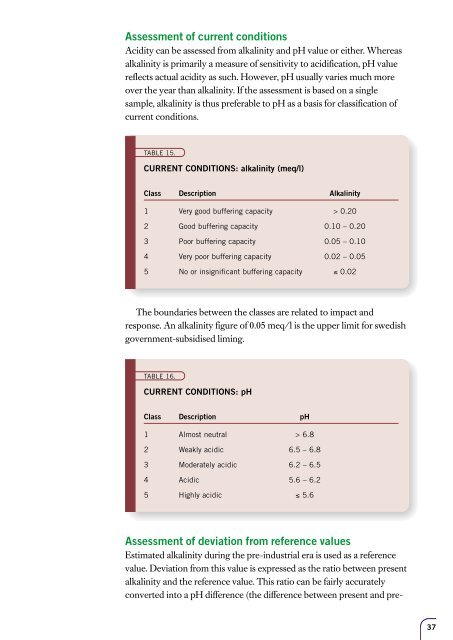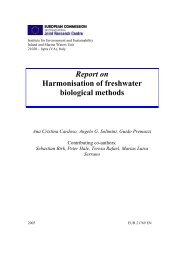Lakes and Watercourses
Lakes and Watercourses
Lakes and Watercourses
Create successful ePaper yourself
Turn your PDF publications into a flip-book with our unique Google optimized e-Paper software.
Assessment of current conditions<br />
Acidity can be assessed from alkalinity <strong>and</strong> pH value or either. Whereas<br />
alkalinity is primarily a measure of sensitivity to acidification, pH value<br />
reflects actual acidity as such. However, pH usually varies much more<br />
over the year than alkalinity. If the assessment is based on a single<br />
sample, alkalinity is thus preferable to pH as a basis for classification of<br />
current conditions.<br />
TABLE 15.<br />
CURRENT CONDITIONS: alkalinity (meq/l)<br />
Class Description Alkalinity<br />
1 Very good buffering capacity > 0.20<br />
2 Good buffering capacity 0.10 – 0.20<br />
3 Poor buffering capacity 0.05 – 0.10<br />
4 Very poor buffering capacity 0.02 – 0.05<br />
5 No or insignificant buffering capacity ≤ 0.02<br />
The boundaries between the classes are related to impact <strong>and</strong><br />
response. An alkalinity figure of 0.05 meq/l is the upper limit for swedish<br />
government-subsidised liming.<br />
TABLE 16.<br />
CURRENT CONDITIONS: pH<br />
Class Description pH<br />
1 Almost neutral > 6.8<br />
2 Weakly acidic 6.5 – 6.8<br />
3 Moderately acidic 6.2 – 6.5<br />
4 Acidic 5.6 – 6.2<br />
5 Highly acidic ≤ 5.6<br />
Assessment of deviation from reference values<br />
Estimated alkalinity during the pre-industrial era is used as a reference<br />
value. Deviation from this value is expressed as the ratio between present<br />
alkalinity <strong>and</strong> the reference value. This ratio can be fairly accurately<br />
converted into a pH difference (the difference between present <strong>and</strong> pre-<br />
37















![Accommodation booking form [PDF]](https://img.yumpu.com/39471785/1/184x260/accommodation-booking-form-pdf.jpg?quality=85)

